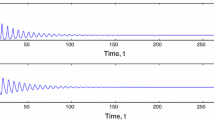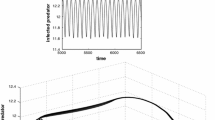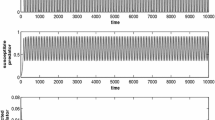Abstract
In this present article, we propose and analyze a cannibalistic predator–prey model with disease in the predator population. We consider two important factors for the dynamics of predator population. The first one is governed through cannibalistic interaction, and the second one is governed through the disease in the predator population via cannibalism. The local stability analysis of the model system around the biologically feasible equilibria are investigated. We perform global dynamics of the model using Lyapunov functions. We analyze and compare the community structure of the system in terms of ecological and disease basic reproduction numbers. The existence of Hopf bifurcation around the interior steady state is investigated. We also derive the sufficient conditions for the permanence and impermanence of the system. The study reveals that the cannibalism acts as a self-regulatory mechanism and controls the disease transmission among the predators by stabilizing the predator–prey oscillations.
















Similar content being viewed by others
References
Anderson, R.M., May, R.M.: The invasion, persistence and spread of infectious diseases within animal and plant communities. Philos. Trans. R. Soc. Lond. B Biol. Sci. 314, 533–570 (1986)
Biswas, S., Samanta, S., Chattopadhyay, J.: Cannibalistic predator–prey model with disease in predator—a delay model. Int. J. Bif. Chaos 25(10), 1550130 (2015)
Biswas, S., Chatterjee, S., Chattopadhyay, J.: Cannibalism may control disease in predator population: result drawn from a model based study. Math. Methods Appl. Sci. 38, 2272–2290 (2015)
Biswas, S., Samanta, S., Chattopadhyay, J.: A model based theoretical study on cannibalistic prey–predator system with disease in both populations. Differ. Equ. Dyn. Syst. 23(3), 327–370 (2015)
Biswas, S., Samanta, S., Khan, Q.J., Chattopadhyay, J.: Effect of multiple delays on the dynamics of cannibalistic prey–predator system with disease in both populations. Int. J. Biomath. (2016). doi:10.1142/S1793524517500498
Boots, M.: Cannibalism and the stage-dependent transmission of a viral pathogen of the Indian meal moth, Plodia interpunctella. Ecol. Entomol. 23, 118–122 (1998)
Butcher, J.C.: Coefficients for the study of Runge–Kutta integration processes. J. Aust. Math. Soc. 3(02), 185–201 (1963)
Chapman, J.W., Williams, T., Escribano, A., Caballero, P., Cave, R.D., Goulson, D.: Fitness consequence of cannibalism in the fall armyworm, Spodoptera frugiperda. Behav. Ecol. 10, 298–303 (1998)
Chapman, J.W., Williams, T., Escribano, A., Caballero, P., Cave, R.D., Goulson, D.: Age-related cannibalism and horizontal transmission of a nuclear polyhedrosis virus in larval Spodoptera frugiperda. Ecol. Entomol. 24, 268–275 (1999)
Chattopadhyay, J., Arino, O.: A predator–prey model with disease in the prey. Nonlinear Anal. 36, 747–766 (1999)
Cushing, J.M.: A simple model of cannibalism. Math. Biosci. 107, 47–71 (1991)
Das, K., Samanta, S., Biswas, B., Chottapadhyay, J.: Occurrence of chaos and its possible control in a predator–prey model with disease in the predator population. J. Ecol. 108, 306–319 (2014)
Das, K.P., Samanta, S., Biswas, S., Alshomrani, A.S., Chattopadhyay, J.: A strategy for a disease-free system—an eco-epidemiological model based study. J. Appl. Math. Comput. (2016). doi:10.1007/s12190-016-1050-7
Desharnais, R.A., Liu, L.: Stable demographic limit cycles in laboratory populations of Tribolium castaneum. J. Anim. Ecol. 56, 885–906 (1987)
Diekmann, O., Nibet, R.M., Gurney, W.S.C., Van den Bosch, F.: Simple mathematical models for cannibalism: a critique and a new approach. Math. Biosci. 78, 21–46 (1986)
Elgar, M.A., Crespi, B.J.: Cannibalism: Ecology and Evolution Among Diverse Taxa. Oxford University Press, New York (1992)
Evirgen, F., Özdemir, N.: Multistage adomian decomposition method for solving NLP problems over a nonlinear fractional dynamical system. J. Comput. Nonlinear Dyn. 6(2), 021003 (2011)
Fatoorehchi, H., Abolghasemi, H., Zarghami, R.: Analytical approximate solutions for a general nonlinear resistor-nonlinear capacitor circuit model. Appl. Math. Model. 39(19), 6021–6031 (2015)
Fatoorehchi, H., Abolghasemi, H., Zarghami, R., Rach, R.: Feedback control strategies for a cerium-catalyzed Belousov–Zhabotinsky chemical reaction system. Can. J. Chem. Eng. 93(7), 1212–1221 (2015)
Fatoorehchi, H., Zarghami, R., Abolghasemi, H., Rach, R.: Chaos control in the cerium-catalyzed Belousov–Zhabotinsky reaction using recurrence quantification analysis measures. Chaos Solitons Fract. 76, 121–129 (2015)
Fox, L.R.: Cannibalism in natural populations. Annu. Rev. Ecol. Syst. 6, 87–106 (1975)
Fraser, C.A., Owens, L.: Spawner-isolated mortality virus from Australian Penaeusmonodon. Dis. Aquat. Org. 27, 141–148 (1996)
Godfray, H.C.J.: Parasitoids: Behavioral and Evolutionary Ecology. Princeton University Press, Princeton (1994)
Greenhalgh, D., Haque, M.: A predator–prey model with disease in the prey species only. Math. Methods Appl. Sci. 30, 911–929 (2007)
Guthrie, D.M., Tindall, A.R.: The Biology of the Cockroach. St. Martins Press, New York (1968)
Hadeler, K.P., Freedman, H.I.: Predator–prey populations with parasitic infection. J. Math. Biol. 27, 609–631 (1989)
Haque, M., Venturino, E.: The role of transmissible diseases in the Holling–Tanner predator–prey model. Theor. Pop. Biol. 70, 273–288 (2006)
Haque, M., Venturino, E.: An ecoepidemiological model with disease in predator: the ratio-dependent case. Math. Methods Appl. Sci. 30, 1791–1809 (2007)
Haque, M.: A predator–prey model with disease in the predator species only. Nonlinear Anal. Real World Appl. 11, 2224–2236 (2010)
Hastings, A.: Cycles in cannibalistic egg–larval interactions. J. Math. Biol. 24, 651–666 (1987)
Hethcote, H.W., Wang, W., Han, L., Ma, Z.: A predator–prey model with infected prey. Theor. Popul. Biol. 665(3), 249–268 (2004)
Hilker, F.M., Schmitz, K.: Disease-induced stabilization of predator–prey oscillations. J. Theor. Biol. 255, 299–306 (2008)
Hofbauer, J.: Saturated equilibria, permanence and stability for ecological systems. In: Groos, L., Hallam, T., Levin, S. (eds.) Proceedings of the 2nd Autumn Course on Mathematical Ecology. World Scientific, Trieste (1986)
Holmes, N.D., Nelson, W.A., Peterson, L.K., Farstad, C.W.: Causes of variations in effectiveness of Bracon cephi (Gahan) (Hymenoptera: Braconidae) as a parasite of the wheat stem sawfly. Can. Entomol. 95, 113–126 (1963)
Hutson, V., Law, R.: Permanent coexistence in general models of three interacting species. J. Math. Biol. 21(3), 285–298 (1985)
Ibáñez, C.M., Chong, J.: Feeding ecology of Enteroctopus megalocyathus (Gould 1852) (Cephalopoda: Octopodidae). J. Mar. Biol. Assoc. UK 88, 793–798 (2008)
Ibanez, C.M., Keyal, F.: Cannibalism in cephalopods. Rev. Fish Biol. Fish. (2009). doi:10.1007/s11160-009-9129-y
Jancovich, J.K., Daviodson, E.W., Morado, J.F., Jacobs, B.L., Colling, J.P.: Isolation of a lethal virus from the endangered tiger salamander Ambystoma tigrinum stebbinsi. Dis. Aquatic Org. 31, 161–167 (1997)
Kohlmeier, C., Ebenhoh, W.: The stabilizing role of cannibalism in a predator–prey system. Bull. Math. Biol. 57, 401–411 (1995)
Magnússon, K.G.: Destabilizing effect of cannibalism on a structured predator–prey system. Math. Biosci. 155, 61–75 (1999)
Richardson, M.L., Mitchell, R.F., Reagel, P.F., Hanks, L.M.: Causes and consequences of cannibalism in noncarnivorous insects. Annu. Rev. Entomol. 55, 39–53 (2010)
Pfennig, D.W., Loeb, M.L.G., Collins, J.P.: Pathogens as a factor limiting the spread of cannibalism in tiger salamanders. Oecologia 88, 161–166 (1991)
Pielou, E.C.: Introduction to Mathematical Ecology. Wiley-Interscience, New York (1969)
Polis, G.A.: The evolution and dynamics of intraspecific predation. Annu. Rev. Ecol. Syst. 12, 225–251 (1981)
Ré, M.E., Gomez-Simes, E.: Hábitos alimentarios del pulpo (Octopus tehuelchus). I. Analisis cuali-cuantitativos de la dieta en el intermareal de Puerto Lobos, Golfo San Mat́ýas (Argentina). Frente Maŕýtimo 11: 119–128 (1992)
Root, R.B., Chaplin, S.J.: The life-styles of tropical milkweed bugs, Oncopeltus (Hemiptera: Lygaeidae), utilizing the same hosts. Ecology 57, 132–140 (1976)
Root, R.B.: The life of a Californian population of the facultative milkweed bug Lygaeus kalmii (Heteroptera: Lygaeidae). Proc. Entomol. Soc. Wash. 88, 201–214 (1986)
Rosenzweig, M.L., MacArthur, R.H.: Graphical representation and stability conditions of predatorprey interactions. Am. Nat. 97, 209–223 (1963)
Rudolf, V.H.W., Antonovics, J.: Disease transmission by cannibalism: rare event or common occurrence? Proc. R. Soc. B 274, 1205–1210 (2007)
Saifuddin, M., Biswas, S., Samanta, S., Sarkar, S., Chattopadhyay, J.: Complex dynamics of an eco-epidemiological model with different competition coefficients and weak Allee in the predator. Chaos Solitons Fract. 91, 270–285 (2016)
Samanta, S., Dhar, R., Pal, J., Chattopadhyay, J.: Effect of enrichment on plankton dynamics where phytoplankton can be infected from free viruses. Nonlinear Stud. 20(2), 225–238 (2013)
Samanta, S., Mandal, A.K., Kundu, K., Chattopadhyay, J.: Control of disease in prey population by supplying alternative food to predator. J. Biol. Syst. 22(04), 677–690 (2014)
Spann, K.M., Cowley, J.A., Walker, P.J., Lester, R.J.G.: A yellow head-like virus, from Penaeusmonodon cultured in Australia. Dis. Aquat. Org. 31, 169–179 (1997)
Van den Bosch, F., Gabriel, W.: Cannibalism in an age-structured predator–prey system. Bull. Math. Biol. 59, 551–567 (1997)
Venturino, E.: The influence of diseases on Lotka–Volterra systems. Rocky Mt. J. Math. 24, 381–402 (1994)
Venturino, E.: Epidemics in predator–prey models: disease in the prey. In: Arino, O., Axelrod, D., Kimmel, M., Langlais, M. (eds.) Mathematical Population Dynamics: Analysis of Heterogeneity, vol. 1: Theory of Epidemics, pp. 381–393. Wuerz Publishing, Winnipeg (1995)
Venturino, E.: Epidemics in predator–prey models: disease in the predators. IMA J. Math. Appl. Med. Biol. 19, 185–205 (2002)
Weaver, D.K., Nansen, C., Runyon, J.B., Sing, S.E., Morrill, W.L.: Spatial distributions of Cephus cinctus Norton (Hymenoptera: Cephidae) and its braconid parasitoids in Montana wheat fields. Biol. Control 34, 1–11 (2005)
Wood, J.B., Kenchington, E., O’Dor, R.K.: Reproduction and embryonic development time of Bathypolypus articus, a deep-sea octopod (Cephalopoda: Octopoda). Malacologia 39, 11–19 (1998)
Yang, X., Chen, L.S.: Permanence and positive periodic solution for the single species nonautonomous delay diffusive model. Comp. Math. Appl. 32, 109–116 (1996)
Ziemba, R.E., Collins, J.P.: Development size structure in tiger salamanders: the role of intraspecific interference. Oecologia 120, 524–529 (1999)
Acknowledgements
The authors are grateful to the anonymous reviewers for their careful reading and valuable comments on the previous version of the paper which help us a lot to improve the manuscript. The research work of Sudip Samanta is supported by NBHM postdoctoral fellowship. Santosh Biswas’s research work is supported by DST-PURSE project (Phase II).
Author information
Authors and Affiliations
Corresponding author
Appendices
Appendix 1
-
(a)
The Jacobian matrix around the interior equilibrium point \(B_{*}(x_{*}, y_{*}, z_{*})\) is given by
$$\begin{aligned} J^{*}= \left[ \begin{array}{ccc} V_{11} &{} V_{12} &{} V_{13} \\ V_{21} &{} V_{22} &{} V_{23} \\ V_{31} &{} V_{32} &{} V_{33} \\ \end{array} \right] , \end{aligned}$$where \(V_{11}=-\frac{rx_{*}}{k}+\frac{(\alpha _{1}y_{*}+\alpha _{2} z_{*})x_{*}}{(\gamma +x_{*})^{2}}, V_{12}=-\frac{\alpha _{1}x_{*}}{\gamma +x_{*}}, V_{13}=-\frac{\alpha _{2}x_{*}}{\gamma +x_{*}}, V_{21}=\frac{\alpha (\alpha _{1}y_{*}+\alpha _{2} z_{*})}{\gamma +x_{*}} -\frac{\alpha (\alpha _{1}y_{*}+\alpha _{2} z_{*})x_{*}}{(\gamma +x_{*})^{2}}, V_{22}=\frac{\alpha \alpha _{1}x_{*}}{\gamma +x_{*}}\,+\,c_{1}\sigma (2\beta y_{*}+z_{*})\,+\,c_{2}\sigma \beta z_{*} -\sigma (2\beta y_{*}+z_{*})-\sigma l f z_{*} - \lambda z_{*}-d, V_{23}=\frac{\alpha \alpha _{2}x_{*}}{\gamma +x_{*}}+c_{1}\sigma y_{*}+c_{2}\sigma (\beta y_{*}+2z_{*})-\sigma y_{*}-\sigma l f y_{*} - \lambda y_{*}, V_{31}=0, V_{32}=\lambda z_{*}+ \sigma l f z_{*}-\sigma \beta z_{*}, V_{33}=-\sigma z_{*}\). The characteristic equation for \(J^{*}\) is
$$\begin{aligned} \mu ^{3}+\varTheta _{1} \mu ^{2}+\varTheta _{2} \mu + \varTheta _{3}=0, \end{aligned}$$(7.1)where \(\varTheta _{1}=-(V_{11} +V_{22}+V_{33}), \varTheta _{2}=V_{11}V_{22}+V_{11}V_{33}+ V_{22} V_{33}- V_{12} V_{21}- V_{23} V_{32}, \varTheta _{3}=-det(J^{*})=V_{11} V_{23} V_{32} + V_{12} V_{21} V_{33} - V_{13} V_{21} V_{32} - V_{11} V_{22} V_{33}\). According to the Routh–Hurwitz criteria the interior equilibrium point \(B_{*}\) is stable if the conditions stated in the theorem hold.
-
(b)
Let \(\varSigma \) be a positive definite Lyapunov function about \(B_{*}(x_{*}, y_{*}, z_{*})\), given by
$$\begin{aligned} \varSigma =\varSigma _{x}+\varSigma _{y}+\varSigma _{z}, \end{aligned}$$
where \(\varSigma _{x}=x-x_{*}-x_{*} ln\frac{x}{x_{*}}, \varSigma _{y}=y-y_{*}-y_{*} ln\frac{y}{y_{*}}, \varSigma _{z}=z-z_{*}-z_{*} ln\frac{z}{z_{*}}\).
Now, computing the time derivative of \(\varSigma _{x}\) along the solution of (2.4), we obtain
Similarly,
Adding these quantities and after some algebraic calculations, we can obtain
The above expression can be written in the form \(-\mathbf {w}^{T}\varOmega \mathbf {w}\), where \(\mathbf {w}=(x-x_{*}, y-y_{*}, z-z_{*})\) and \(\varOmega \) is the symmetric matrix given by
with \(\varOmega _{11}= \frac{r}{k}-\frac{(\alpha _{1} y_{*}+ \alpha _{2}z_{*})}{(\gamma +x)(\gamma +x_{*})}, \varOmega _{12}= \frac{1}{2} \{ \frac{\alpha _{1}}{(\gamma +x)}-\frac{\alpha \alpha _{1} \gamma }{(\gamma +x)(\gamma +x_{*})}- \frac{\alpha \alpha _{2} \gamma z_{*}}{(\gamma +x)(\gamma +x_{*})y} \}, \varOmega _{13}= \frac{1}{2} \frac{\alpha _{2}}{(\gamma +x)}, \varOmega _{22}=\sigma (1-c_{1})\beta +\frac{c_{2} \sigma z^{*^{2}}}{y_{*}y}+ \frac{\alpha \alpha _{2} x_{*}z_{*}}{(\gamma +x_{*})y_{*}y}, \varOmega _{23}=\frac{1}{2} \{ \sigma (1-c_{1})+\sigma \beta (1-c_{2})-c_{2} \sigma \frac{z}{y}-c_{2} \sigma \frac{z_{*}}{y}- \frac{\alpha \alpha _{2} x}{(\gamma +x)y}\}, \varOmega _{33}=\sigma \).
Thus, \({\dot{\varSigma }}\) is negative definite if the symmetric matrix \(\varOmega \) is positive definite. The matrix \(\varOmega \) is positive definite, if all the principal minors \({\mathbb {P}}_{1}= \varOmega _{11}, {\mathbb {P}}_{2}= \varOmega _{11} \varOmega _{22}-\varOmega _{12}^{2}, {\mathbb {P}}_{3}=\varOmega _{11}\varOmega _{22}\varOmega _{33}+2\varOmega _{12}\varOmega _{13}\varOmega _{23}-\varOmega _{11}\varOmega _{23}^{2}-\varOmega _{22}\varOmega _{13}^{2}-\varOmega _{33}\varOmega _{12}^{2}\) of \(\varOmega \) are positive, i.e.,
- (i):
-
\({\mathbb {P}}_{1}=\frac{r}{k}-\frac{(\alpha _{1} y_{*}+ \alpha _{2}z_{*})}{(\gamma +x)(\gamma +x_{*})} >0\),
- (ii):
-
\({\mathbb {P}}_{2}=[\frac{r}{k}-\frac{(\alpha _{1} y_{*}+ \alpha _{2}z_{*})}{(\gamma +x)(\gamma +x_{*})}] [ \sigma (1-c_{1})\beta +\frac{c_{2} \sigma z^{*^{2}}}{y_{*}y}+ \frac{\alpha \alpha _{2} x_{*}z_{*}}{(\gamma +x_{*})y_{*}y}]-[\frac{1}{2} \{\frac{\alpha _{1}}{(\gamma +x)}-\frac{\alpha \alpha _{1} \gamma }{(\gamma +x)(\gamma +x_{*})}- \frac{\alpha \alpha _{2} \gamma z_{*}}{(\gamma +x)(\gamma +x_{*})y} \}]^{2} >0\),
- (iii):
-
\({\mathbb {P}}_{3}=\varOmega _{33}(\varOmega _{11}\varOmega _{22}-\varOmega _{12}^{2})+\varOmega _{23}(\varOmega _{12}\varOmega _{13}-\varOmega _{11}\varOmega _{23})+\varOmega _{13}(\varOmega _{12}\varOmega _{23}-\varOmega _{22}\varOmega _{13})>0\).
For \({\mathbb {P}}_{1}\), we have by (4.3) \({\mathbb {P}}_{1}(x)=\frac{r}{k}-\frac{(\alpha _{1} y_{*}+ \alpha _{2}z_{*})}{(\gamma +x)(\gamma +x_{*})}>{\mathbb {P}}_{1}(0)=\frac{r}{k}-\frac{(\alpha _{1} y_{*}+ \alpha _{2}z_{*})}{\gamma (\gamma +x_{*})}>0\) since \(\dot{{\mathbb {P}}_{1}}(x)=\frac{(\alpha _{1} y_{*}+ \alpha _{2}z_{*})}{(\gamma +x)^{2}(\gamma +x_{*})}>0\).
For \({\mathbb {P}}_{2}\), using (4.3) and (4.4), we have
Now for \({\mathbb {P}}_{3}\), we have
From (4.5), we have \(\varOmega _{23}=\frac{1}{2} \{ \sigma (1-c_{1})+\sigma \beta (1-c_{2})-c_{2} \sigma \frac{z}{y}-c_{2} \sigma \frac{z_{*}}{y}- \frac{\alpha \alpha _{2} x}{(\gamma +x)y}\}>0\).
Using (4.4) and (4.6), for \({\mathbb {P}}_{3}\), we get
Above results suggest that \({\mathbb {P}}_{3}>0\), so the conditions (i), (ii) and (iii) imply that \({\dot{\varSigma }}<0\) along the trajectories. Therefore, system (2.4) is globally stable around the interior equilibrium point \(B_{*}\) according as the conditions stated in the theorem hold.
Appendix 2
Let \(\mu (\sigma )=\varrho (\sigma )+ i \varsigma (\sigma )\) for all \(\sigma \in R^{+}\), the characteristic value of the characteristic Eq. (7.1). Substituting this value in Eq. (7.1), and separate real and imaginary parts as
A necessary condition for a Hopf bifurcation of \(B_{*}\) is that the characteristic equation (7.1) should have purely imaginary solutions. For the Hopf bifurcation to occur at \(\sigma =\sigma ^{*}\), substituting \(\varTheta _{1}(\sigma ^{*})\varTheta _{2}(\sigma ^{*})=\varTheta _{3}(\sigma ^{*})\) into Eq. (7.1), the characteristic equation must be of the form
Thus, the characteristic values of the Eq. (7.4) are \(\mu _{1,2}(\sigma ^{*})=\pm i\sqrt{\varTheta _{2}(\sigma ^{*})}=\pm i\varsigma ^{*}\) and \(\mu _{3}(\sigma ^{*})=-\varTheta _{1}(\sigma ^{*})\). By using the condition (i) of the Theorem 4, we have \(\varsigma ^{*}>0\) and \(\mu _{3}(\sigma ^{*})<0\).
Now, we can verify the transversality condition
Calculating the derivative of (7.2) and (7.3) w.r.t. \(\sigma \) and substituting \(\varrho =0, \varsigma =\varsigma ^{*}\) and \(\sigma =\sigma ^{*}\), we get
where \(\mathcal {P}=-2\varTheta _{2}(\sigma ^{*}), \mathcal {Q}=2\varTheta _{1}(\sigma ^{*})\sqrt{\varTheta _{2}(\sigma ^{*})}, \mathcal {L}=\acute{\varTheta _{1}}(\sigma ^{*})\varTheta _{2}(\sigma ^{*})-\acute{\varTheta _{3}}(\sigma ^{*}), \mathcal {M}=-\acute{\varTheta _{2}}(\sigma ^{*})\sqrt{\varTheta _{2}(\sigma ^{*})}\).
Solving for \(\acute{\mu }(\sigma ^{*})\) from system (7.6) we obtained
Hence \(\acute{\mu }(\sigma ^{*})>0\), if \(\varTheta _{2}(\sigma ^{*}) > 0\) and \(\acute{\varTheta _{3}}(\sigma ^{*})>[\varTheta _{1}(\sigma ^{*})\varTheta _{2}(\sigma ^{*})]^{'}\). Therefore, the transversality condition is satisfied and a Hopf bifurcation occurs when \(\sigma \) passes through the critical value \(\sigma ^{*}\).
Appendix 3
Let \(\tilde{p}\) be a point in the positive quadrant and \(o(\tilde{p})\) be orbit through \(\tilde{p}\) and \(\tilde{\varOmega }(\tilde{p})\) be the bounded omega limit set of the orbit through \(\tilde{p}\). \(W^{s}(B_{r})\) denotes the stable manifold of \(B_{r}, r=1,2\).
Clearly \(B_{0}\notin \tilde{\varOmega }(\tilde{p})\). If possible, let \(B_{0}\in \tilde{\varOmega }(\tilde{p})\) then by the Butler-McGehee lemma there exists a point m in \(\tilde{\varOmega }(\tilde{p})\cap W^{s}(B_{0})\). But, o(m) lies in \(\tilde{\varOmega }\) and \(W^{s}(B_{0})\) is the yz-plane, which shows that o(m) is unbounded, a contradiction.
Next we show that \(B_{1}\notin \tilde{\varOmega }(\tilde{p})\). If \(B_{1}\in \tilde{\varOmega }(\tilde{p})\), the condition \(R_{01}>1\) implies that \(B_{1}\) is a saddle point, then applying the Butler–McGehee lemma there exists a point m in \(\tilde{\varOmega }(\tilde{p})\cap W^{s}(B_{1})\). Now \(\tilde{\varOmega }(\tilde{p})\cap W^{s}(B_{1})\) is the xz-space and hence orbit in this plane emanate from either \(B_{1}\) or an unbounded orbit lies in \(\tilde{\varOmega }(\tilde{p})\), which is a contradiction.
Finally, we show that no periodic orbit solution in the xy-space or \(B_{2}\in \tilde{\varOmega }(\tilde{p})\). If \(q_{j}, j=1, 2,\ldots , n\) denote the closed orbit of the periodic solution \((\varphi _{q}(t), \psi _{q}(t))\) in xy-space such that \(q_{j}\) lies inside \(q_{j-1}\). Let, the Jacobian matrix J of the system (2.4) corresponding to \(q_{j}\) be denoted by \(J_{q}(\varphi _{q}(t), \psi _{q}(t), 0)\). The fundamental matrix of the linear periodic system is given by
We find that, \(e^{\zeta _{q}\mathcal {T}}\) is the Floquet multiplier of (7.7) in the direction of z. Then applying the process as proposed by Kumar and Freedman (1989), we conclude that no \(q_{j}\) lies on \(\tilde{\varOmega }\). Therefore, \(\tilde{\varOmega }\) lies in the positive quadrant and system (2.4) is persistent. Since only the closed orbits and the equilibria from the omega limit set of the solutions are on the boundary of \(R^{3}_{+}\) and system (2.4) is dissipative. Thus, the system (2.4) is uniformly persistent by the main theorem of Butler et al. (1986).
Rights and permissions
About this article
Cite this article
Biswas, S., Samanta, S. & Chattopadhyay, J. A cannibalistic eco-epidemiological model with disease in predator population. J. Appl. Math. Comput. 57, 161–197 (2018). https://doi.org/10.1007/s12190-017-1100-9
Received:
Published:
Issue Date:
DOI: https://doi.org/10.1007/s12190-017-1100-9
Keywords
- Cannibalism
- Disease transmission
- Holling type II
- Disease basic reproduction number
- Lyapunov function
- Hopf bifurcation




